
|
You entered: surface
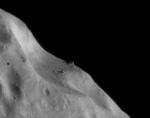 Eros Craters And Boulders
Eros Craters And Boulders
21.07.2000
From a delicate orbit around asteroid 433 Eros, the NEAR Shoemaker spacecraft's camera has now imaged the entire surface of the small oddly-shaped world at least once. Recorded on July 7th from a distance of 50 kilometers, this dramatic view is about 1.8 kilometers across.
 A Venus Landing
A Venus Landing
24.01.1999
This image is part of the first color panoramic view from Venus. It was transmitted by a TV camera on the Soviet Venera 13 lander which parachuted to thesurface on March 1, 1982. Venus...
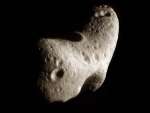 Asteroid Eros Reconstructed
Asteroid Eros Reconstructed
7.06.2009
Orbiting the Sun between Mars and Earth, asteroid 433 Eros was visited by the robot spacecraft NEAR-Shoemaker in 2000 February. High-resolution surface images and measurements made by NEAR's Laser Rangefinder (NLR) have been combined into the above visualization based on the derived 3D model of the tumbling space rock.
 Neutron Mars
Neutron Mars
15.03.2002
Looking for water on Mars, researchers using detectors on board the orbiting Mars Odyssey spacecraft have created this false-color global map of energetic neutrons from the otherwise Red Planet. What do neutrons have to do with water?
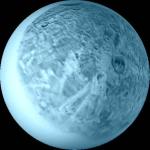 Hamlet of Oberon
Hamlet of Oberon
31.01.1998
What's in a name? Since 1919, the International Astronomical Union has been charged with the task of establishing "conventional" nomenclature for planets, satellites, and surface features. For the remote Uranian system of moons, namesakes from Shakespearean works have been chosen.
 Welcome to a Comet
Welcome to a Comet
13.11.2014
The Rosetta Mission lander is safely on a comet. One of Philae's feet appears at the bottom left of this spectacular image of the surface of C67/P Churyumov-Gerasimenko. Still a happy lander, Philae...
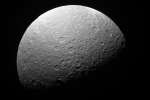 Ancient Craters of Southern Rhea
Ancient Craters of Southern Rhea
13.05.2008
Saturn's ragged moon Rhea has one of the oldest surfaces known. Estimated as changing little in the past billion years, Rhea shows craters so old they no longer appear round their edges have become compromised by more recent cratering.
 A Venus Landing
A Venus Landing
30.11.2003
This image is part of the first color panoramic view from Venus. A TV camera on the Soviet Venera 13 lander that parachuted to the surface on 1982 March 1 transmitted it. Venus' clouds...
 Mars Rocks, Sojourner Rolls
Mars Rocks, Sojourner Rolls
30.10.1999
This sharp color image featuring Mars rock Yogi and the rolling Sojourner robot shows off Yogi's two-toned surface. Yogi appears to be leaning into the prevailing winds causing some to suggest that its color contrast may be caused by the accumulation of rust colored dust on its windward face.
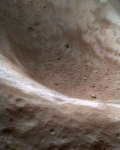 The Regolith of Asteroid Eros
The Regolith of Asteroid Eros
19.06.2011
From fifty kilometers above asteroid Eros, the surface inside one of its largest craters appears covered with an unusual substance: regolith. The thickness and composition of the surface dust that is regolith remains a topic of much research.
|
January February March April May June July |
|||||||||||||||||||||||||||||||||||||||||||||||||